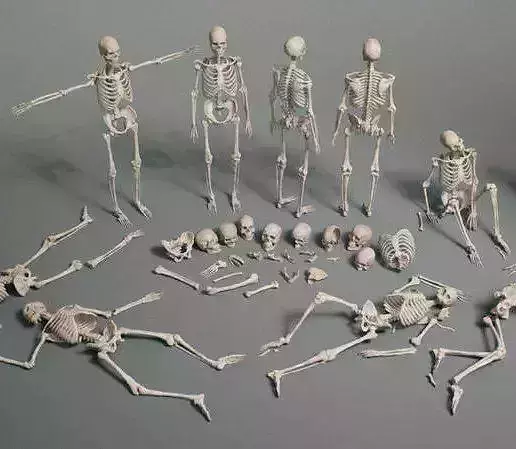1/12
Included: 12 folders + separate file versionsFormat: High-resolution, fully detailed anatomy model
This meticulously crafted model represents the complete human skeleton, offering exceptional detail and anatomical accuracy. Ideal for educational, medical, and artistic applications, the model provides an in-depth look at all major bones in the body.
The human skeleton serves as the framework of the body, offering structure, support, and protection. While infants are born with approximately 270 bones, adults typically have 206, due to bone fusion over time.
Axial SkeletonThe axial skeleton forms the central axis of the body, including the skull, vertebral column, and rib cage, which protect the brain, spinal cord, and vital organs.
Skull (22 Bones Total) Cranial Bones (8): Encase and protect the brain.Frontal Bone: Forehead
Parietal Bones (2): Top/sides of the skull
Temporal Bones (2): Lower sides; ear region
Occipital Bone: Back of skull; foramen magnum
Sphenoid Bone: Central skull base
Ethmoid Bone: Roof of the nasal cavity
Facial Bones (14): Shape the face
Maxillae (2): Upper jaw
Zygomatic Bones (2): Cheekbones
Nasal Bones (2): Bridge of nose
Palatine Bones (2): Hard palate
Lacrimal Bones (2): Eye orbit; tear ducts
Inferior Nasal Conchae (2): Nasal cavity
Vomer: Nasal septum
Mandible: Lower jaw; only movable skull bone
Vertebral Column (33 Vertebrae) Cervical (7): NeckThoracic (12): Upper/mid-back
Lumbar (5): Lower back
Sacrum (5 fused): Pelvic connection
Coccyx (4 fused): Tailbone
Rib Cage (25 Bones) Ribs (24): 12 pairs protecting chest cavitySternum (1): Central breastbone
Appendicular SkeletonThe appendicular skeleton includes the limbs and girdles, enabling movement and interaction with the environment.
Pectoral Girdle Clavicles (2): Collar bonesScapulae (2): Shoulder blades
Upper Limbs (60 Bones) Humerus (2): Upper armsRadius (2): Forearms (thumb side)
Ulna (2): Forearms (pinky side)
Carpals (16): Wrists (8 per side)
Metacarpals (10): Hands (5 per hand)
Phalanges (28): Fingers (3 per finger, 2 per thumb)
Pelvic GirdleHip Bones (2): Formed by ilium, ischium, pubis
Lower Limbs (60 Bones)Femur (2): Thighs; longest bone
Patella (2): Kneecaps
Tibia (2): Shins; weight-bearing
Fibula (2): Outer lower legs
Tarsals (14): Ankles (7 per foot)
Metatarsals (10): Feet (5 per foot)
Phalanges (28): Toes (3 per toe, 2 per big toe)
Functions of the SkeletonSupport: Structural foundation of the body
Protection: Shields internal organs
Movement: Acts as levers for muscles
Mineral Storage: Reservoir for calcium, phosphorus
Blood Cell Production: Occurs in red bone marrow (hematopoiesis)
This high-resolution model and accompanying anatomical reference provide a powerful tool for learning, visualization, and presentation. Each bone is essential in maintaining the function and integrity of the human body.
3D printing settingsRecommended Printer Type: FDM, SLA, or ResinScale: 1:1 or as preferredSupports Required: Yes (for complex areas like ribs, skull cavities, etc.)Orientation: Lay bones flat or as advised per part to reduce supportsLayer Height: 0.1–0.2 mmInfill: 10–20% (higher for sturdier parts)Material: PLA, ABS, PETG, or ResinNozzle Size: 0.4 mm (standard)Print Bed Adhesion: Brim or raft recommended for tall bonesPost-Processing:
Remove supports carefully with pliers or cutters
Light sanding or resin curing for clean finish
Optional painting or coating for realism
Note: This model is primarily designed for 3D printing. If converting to 2D profiles for CNC or laser cutting, consider the following:
Material Suggestions: MDF, Acrylic, Plywood, FoamMinimum Thickness: 3 mm or higherLaser Cutting Type: CO₂ laser recommendedFeed Rate & Speed: Adjust per material; use test cutsAssembly Notes: May require joining slots or pegs manually designed
REVIEWS & COMMENTS
accuracy, and usability.












